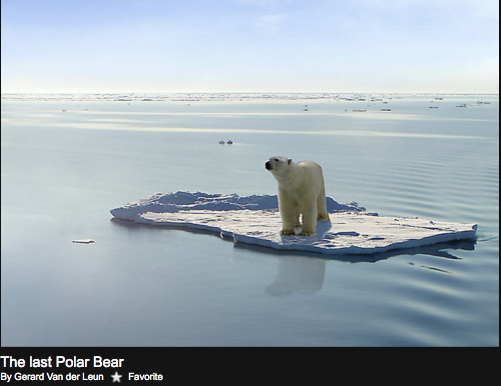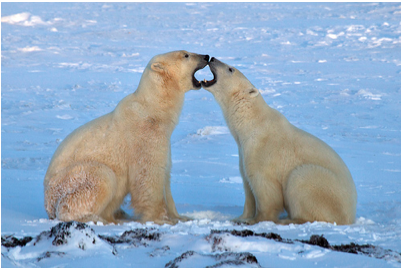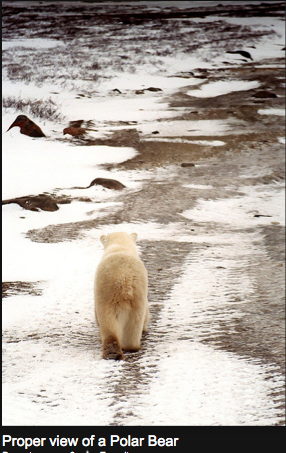The Story of Polar Bears

Since the 1980s, Arctic sea ice has been retreating very rapidly due principally to global warming. Polar regions are amongst the most affected by climate change in the world. In part, this is because ice has higher reflectivity compared to the ocean or the land, which has the effect of increasing the absorption of the sun's heat and eventually of warming the Polar regions. Polar bears, who only live in the Arctic, have been affected by climate change as it especially influences the way they hunt and breed within their habitat that is continuously retreating. It is predicted that polar bears could become extinct in the next century or so primarily because of the consequences of global warming in the Arctic. However, climate change is not the only reason polar bears are classified as vulnerable by the IUCN Red List. Additional factors are also responsible for their vulnerability such as pollutants in the air, oil exploitattion, hunting, and amongst many others.
Polar bears are the largest terrestrial predator on Earth (WWF). They are at the top of the food chain in the Arctic region, where their principal preys are ringed seals (PBI). Polar bears are the greatest carnivorous of all the bears that exist on Earth. There are 19 sub-populations of polar bears in the world and their current count is estimated to be between 20-25,000 worldwide (WWF). Five nations within the Arctic region have polar bears populations: Canada, the United States (Alaska), Greenland, Norway, and Russia. Amongst them, Canada is the country with the most polar bears, approximately 60% of the total population, which represents approximately 15,500 bears (WWF).

Image source: Flickr
In Canada, the bears can specifically be found in the province of Manitoba, Newfoundland, Labrador, Nunavut, Northwest Territories, Quebec, Yukon Territory, and Ontario. For the most part, polar bears are more likely to live in shallow water areas near the shore or where currents and streams increase biological productivity near ice zones particularly associated with open water (IUCN).
Over the past few decades, the lives of polar bears have been disturbed by climate change caused principally by greenhouse gas emissions, and as a consequence reduced the thickness and extent of sea ice in the Arctic. According to the WWF, air temperatures in the Arctic have on average increased by approximately 5°C over the last 100 years. They have been facing rapid loss of sea ice, which is their main habitat where they hunt, breed, as well as den. Essentially, polar bears rely on sea ice for their survival. Since these changes in temperatures affect their access to preys, especially their principal one, ringed seals, the bears consume less food then they would usually do. As a consequence, they fail to reproduce more frequently and when females give birth, their cubs tend to be smaller and they have a higher risk of dying at a young age.
Moreover, polar bears may be required to move on shore for prolonged periods of time and rely on their fat reserves accumulated the previous spring for their survival. Hudson Bay is the greatest example for this kind of situation. In this southern Canadian region where many bears live, sea ice is melting earlier in the spring and forming later during fall. According to the WWF, the population of polar bears in western Hudson Bay in Northern Canada has declined from approximately 1,200 bears in 1987 to about 950 bears in 2004. The principal cause is associated to global warming.
During the summer season, the ice in Hudson Bay melts completely, which force polar bears to remain on land while having little access to food sources. Moreover, according to a recent study published in the Nature Communications journal, it has been predicted that due to the loss of sea ice, there could be a diminution in polar bears litter size. Global warming is a very important issue nowadays and polar bears are very vulnerable to this threat.
Though climate change is the most important factor that contributes to the decline in polar bear populations, it is not the only one. Many other factors are important to consider when looking at the vulnerable status of polar bears. Hunting is the most important issue amongst them. For many years now, over-harvesting of polar bears has been a significant concern because they have been severely depleted. In 1973, the five polar bear nations, such as Canada and the United States, signed an international agreement to end the unregulated hunting. Nowadays, legal hunting kills more than 700 polar bears every year. According to the IUCN red list of threatened species, the principal use of polar bears is for subsistence reasons. These include eating their meat, using their skin for clothes such as mittens and boots, using their fur for clothing and many others.
Another factor that influences the decline of polar bear populations is toxic pollution. According to the WWF, the Arctic food chain contains high levels of toxic chemicals mainly due to the direction of the wind and ocean currents, which drives these organic pollutants through the Arctic. As a consequence, polar bears with high levels of persistent organic pollutants tend to have lower levels of vitamin A, thyroid hormones, and antibodies in their body (WWF). As a result, it can negatively affect some of their biological functions such as their growth patterns, reproduction, their behavior, immune system, as well as the ability of their body to combat diseases (WWF).
Another important negative aspects to consider regarding pollutants is that bear cubs are more likely to be affected by these chemicals because the mothers' milk contains elevated concentrations of these substances. This could eventually lead to lower survival rates for young cubs. One more threat that plays an important role for polar bears and their habitat is oil exploration in the Arctic. Because of the extraction, transportation, and processing of petroleum in the Arctic, it directly affects polar bears in many different ways. According to the WWF, the principal consequence is that the bears could lose insulation if the oil touches their fur. As a result, they need to use more energy so they could stay warm and they must compensate for this energy loss by consuming more food, which is sometimes difficult for them.
Many governmental and non-governmental organizations and agencies around the world are currently taking actions to help and save polar bears. For instance, the World Wildlife Fund (WWF) is the world's leading conservation organization, which works at the local and global level in more than 100 countries worldwide. Some of their most important objective concerning polar bears include; find out how climate change will affect the long-term condition of polar bears, work with governments and societies to help reduce greenhouse gas emissions, protect the bears' habitat and finally prevent or completely remove threats from oil activity in the Arctic (WWF). Also, Polar Bears International, a nonprofit organization, has been dedicated to the preservation of polar bears since 1992. For many years, they have been studying the effects of global warming on polar bears in order to be able to inform and enlighten people around the world about the major consequences in the Arctic.
Furthermore, the government of Canada, particularly Environment Canada, has implemented many policies regarding the protection of its iconic creatures. For instance, they have established many protected areas for habitat that are essential to polar bears in some of Canada's National Parks, national and marine wildlife areas and also in some provincial parks (Environment Canada). Most importantly, it is crucial for people to understand that global action is necessary to reduce greenhouse gases because this is where the problem comes from in the first place.
For many experts and scientists from around the globe, the future of polar bears is very uncertain. Many predict that if global warming continues to intensify, polar bears may become extinct from most of their range in the next 100 years. If we do not decrease our consumption of greenhouse gases, global temperatures and water temperatures will continue to increase, which will result in even more loss of sea ice in the Arctic. According to a fact sheet published by the WWF in May 2002, it has been mentioned that a warming trend had been observed in the Arctic, which resulted in a 3% decrease of sea ice extent each decade since the 1970s and also more melting days happened every summer. It is expected to continue increasing in the future years. While using computer models, experts indicated that if CO2 in the atmosphere continues to increase to the point where it might double in concentration, the ice-free season would grow from 60 days to approximately 150 days (WWF). It is imperative to take action immediately to help and save polar bears or soon the bears' populations will completely disappear from the polar region of Arctic.

Image source: Flickr
Works Cited
¨Effects of Climate Change on Polar Bears Factsheet¨. WWF Norway. Feb. 2008. PDF File.
Cox, Daniel J. Photographies. Polar Bears International. Web. 11 April 2011.
Norris, Stefan; Rosentrater, Lynn; Eid, Pal Martin. ¨Polar Bears ar Risk¨. WWF International Arctic Program. May 2002. PDF File.
Scott, Julian B. T., and Gareth J. Marshall. "A Step-Change in the Date of Sea-Ice Breakup in Western Hudson Bay." Arctic 63.2 (2010): 155-164. Academic Search Complete. EBSCO. Web. 2 Mar. 2011.
Stirling, Ian et al. "Survival and
breeding of polar bears in the southern Beaufort Sea in relation to sea ice." Journal of Animal Ecology 79.1
(2010): 117-127. Academic Search Complete.
EBSCO. Web. 2 Mar. 2011.
Stirling, Ian, and Claire L. Parkinson. "Possible Effects of Climate Warming on Selected Populations of Polar Bears (Ursus maritimus) in the Canadian Arctic." Arctic 59.3 (2006): 261-275. Academic Search Complete. EBSCO. Web. 2 Mar. 2011.
Canada Polar Bears. Fresh Tracks Canada. 1992. Web. 5 April 2011.
Polar Bears International. n.p. 1992. Web. 2 April 2011.
The IUCN Red List of Threatened Species. International Union for Conservation of Nature. 1948. Web. 2 April 2011.
World Wildlife Found. n.p. 29 April 1961. Web. 2 April 2011.
Leave a comment